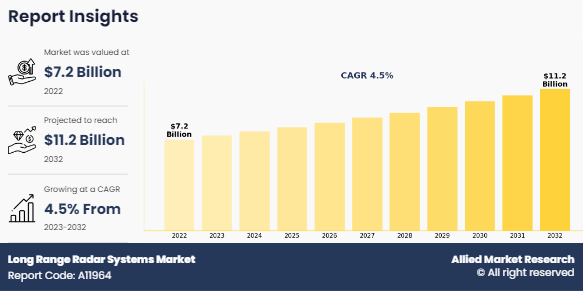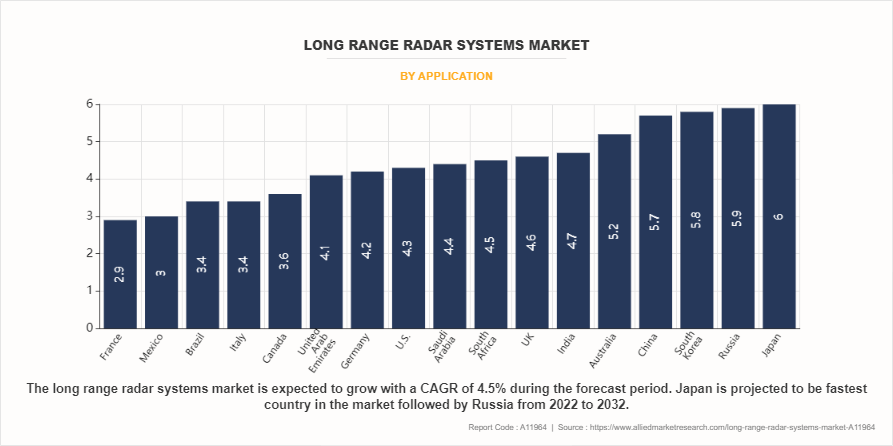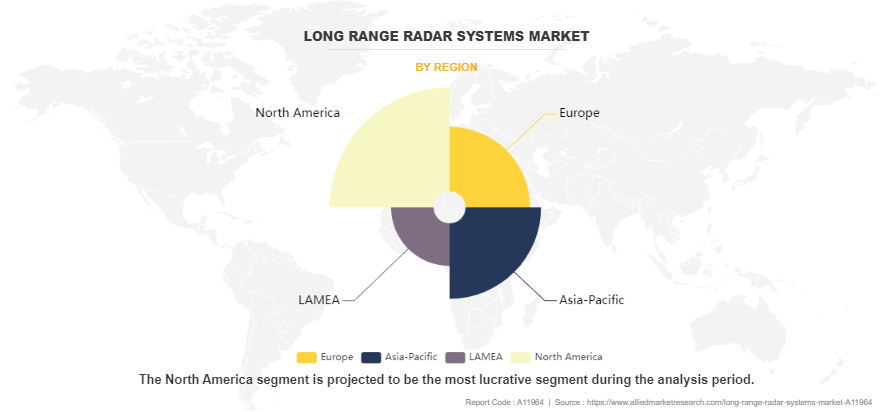The global long range radar systems market size was valued at $7.2 billion in 2022, and is projected to reach $11.2 billion by 2032, growing at a CAGR of 4.5% from 2023 to 2032. Long range radar systems are sophisticated surveillance technologies designed to detect and track aircraft, surface ships, and other potential threats over vast distances.

The long range radar systems industry utilize high-frequency radar waves, such as those used in the relocatable over-the-horizon radar (ROTHR), which bounce off the ionosphere to achieve extended ranges similar to shortwave radio. Long range radar systems plays a critical role in providing early warning of potential strikes against aircraft carrier task forces and conducting long range surveillance of large open-water areas, covering distances of up to 2,500 nautical miles.
The long range radar systems market demand is primarily driven by the need for enhanced situational awareness and early threat detection in maritime and coastal regions. As demonstrated by the ROTHR system, which has been operational for over 25 years, these radar systems are instrumental in supporting various missions, including counter-drug operations and early warning detection for navy vessels at sea.
Key Takeaways of Long Range Radar Systems Market Report
- Based on application, the airborne sub-segment emerged as the global leader in 2022 and is anticipated to be the fastest growing during the forecast period.
- Based on region, North America registered the highest market share in 2022 and Asia-Pacific is anticipated to show the fastest growth during the forecast period.
Segment Overview
The long range radar systems market is segmented based on its Application.

By Application
The airborne sub-segment dominated the global long range radar systems in 2022. The demand for long range radar systems in airborne applications is high due to their critical role in providing situational awareness, early threat detection, and navigation assistance in the aerospace domain. These radar systems offer a range of features tailored to meet the specific requirements of long-range applications. Firstly, long range radar systems provide extended detection ranges, allowing aircraft to detect potential threats, such as other aircraft, missiles, or adverse weather conditions, from a considerable distance. This early detection capability is crucial for enhancing aircraft safety and enabling timely decision-making by aircrew and ground controllers.
Secondly, these radar systems offer high-resolution target imaging and tracking capabilities, enabling precise identification and monitoring of objects within their coverage area. This feature is essential for distinguishing between friend and foe, tracking multiple targets simultaneously, and maintaining continuous surveillance over large airspace volumes. In addition, long range radar systems are designed to operate effectively in various environmental conditions, including adverse weather, low visibility, and electronic warfare environments. Their robustness and reliability ensure consistent performance across different operational scenarios, enhancing mission effectiveness and survivability.
Moreover, modern long range radar systems incorporate advanced signal processing algorithms and software-defined architectures, enabling real-time adaptation to evolving threats and mission requirements. This flexibility allows for seamless integration with existing aircraft systems and facilitates future upgrades to enhance system capabilities. Overall, the combination of extended detection ranges, high-resolution imaging, environmental resilience, and adaptive processing capabilities makes long-range radar systems indispensable assets for airborne applications. These factors are anticipated to have a positive impact on the long range radar systems market size during the forecast years.

By Region
North America dominated the global long range radar systems market in 2022. The long range radar systems industry has gained huge popularity in North American countries namely U.S., Canada, and others. For instance, Canada, with its extensive land and maritime borders, relies on long-range radar systems to monitor vast territories and coastal areas for security and defense purposes. These radar systems are essential components of Canada's air defense infrastructure, enabling early detection and response to potential aerial threats and incursions into Canadian airspace.
In addition, long-range radar systems contribute to Canada's maritime surveillance efforts, helping to detect and track maritime vessels, including those engaged in illegal activities or posing security risks. The defense budgets of both the U.S. and Canada allocate significant funding for the procurement, development, and maintenance of advanced radar systems, highlighting the importance placed on enhancing national defense capabilities and maintaining strategic readiness. For instance, the U.S. defense budget for fiscal year 2022 was approximately $753.5 billion, while Canada's defense budget for the same period was approximately CAD 25.1 billion (approximately $20 billion).
Given the vast territorial expanse and diverse security challenges faced by North American countries, including potential threats from state and non-state actors, long-range radar systems are considered indispensable assets for safeguarding national sovereignty, protecting critical infrastructure, and ensuring homeland security. These factors are anticipated to boost the North America long range radar systems market share in the upcoming years.
Competitive Analysis
The key players profiled in this report include Lockheed Martin Corporation, Raytheon Technologies Corporation, Thales Group, Honeywell International Inc., BAE Systems plc, Leonardo S.p.A., Rheinmetall AG, Northrop Grumman Corporation, Saab AB, and Hensoldt GmbH. Product launch, technological advancement, partnership, and business expansion are the key strategies adopted by the market players.
For instance, in May 2022, Lockheed Martin, global aerospace, defense, and security company headquartered in Maryland, U.S., successfully completed the production of its first ground-based air defense radar, the AN/TPY-4, aimed at bolstering tracking precision for the U.S. and its allied nations. This milestone follows its recent selection by the U.S. Air Force (USAF) for the three-dimensional expeditionary long-range radar (3DELRR) rapid prototyping program. The AN/TPY-4 radar, designated AN/TPY-4(V)1 by the U.S. Government, is equipped with the platform electronics subsystem (PES) from Kongsberg Defense & Aerospace.
This radar system, designed with advanced defense technology, addresses the evolving threats in modern battlefields with its capability to track existing and emerging threats. Its fully digital, software-defined sensor architecture enables operation in contested environments, offering ease of integration and long-term support. In addition, the radar's adaptability to operational changes through software enhancements, without requiring hardware modifications, enhances its effectiveness. With the ability to detect small or hard-to-detect targets and operate in adverse weather conditions, the AN/TPY-4 radar contributes to enhancing air defense capabilities for both the U.S. and allied nations.
Market Dynamics
Efficient Monitoring and Surveillance of Air Traffic Offered by Long Range Radar Systems to Drive the Market Growth
The ability of long-range radar systems to be relocated and redeployed further enhances their utility, enabling monitoring of air traffic and surveillance in different operational theaters. The continuous evolution and upgrading of long range radar systems, as exemplified by Raytheon Technologies Corp.'s efforts to enhance ROTHR performance and reliability, highlight the importance of technological advancements in driving the capabilities of these systems. State-of-the-art computers, displays, and enhanced software contribute to more accurate tracking of small aircraft and boats, improving overall surveillance effectiveness. In addition, the geographical coverage provided by long range radar systems, spanning millions of square miles, highlights their significance in strengthening national security and maritime domain awareness. These factors are anticipated to drive the long range radar systems market growth in the upcoming years.
The Wide Beam Range of Radar Systems, Along With Their Limited Target Specificity to Restrain the Market Expansion
Long range radar systems, while offering extensive surveillance capabilities, are subject to various constraints that can impact their effectiveness in certain scenarios. For instance, the time taken to lock onto an object can be relatively longer due to the travel time of radio signals, leading to potential delays in acquiring accurate target data. In addition, the wide beam range of radar systems, along with their limited target specificity, results in indiscriminate coverage and difficulties in distinguishing between multiple targets or resolving individual objects within a cluttered environment. Also, interference from external sources, such as airborne obstacles or conducting materials, can further impede radar performance, affecting signal resolution and target differentiation. In addition, radar systems lack the ability to discern certain characteristics of targets, such as color or type, and may provide incomplete or inaccurate data requiring specialized training for analysis and interpretation. These factors are anticipated to hamper the long range radar systems sales in the upcoming years.
Technological Advancements Such as Advanced Signal Processing Algorithms to Drive Excellent Market Opportunities
The advancements in the long range radar systems such as the 24-GHz frequency-modulated continuous-wave (FMCW) radar with sectoral horn antennas presents significant opportunities for the long range radar systems market players. This is because by employing radar systems with extended range capabilities, personnels can effectively monitor airspace and identify potential threats posed by unauthorized drone activity, thereby enabling timely intervention to mitigate risks. Also, the integration of advanced signal processing algorithms, such as the proposed 3D subspace-based algorithm for joint range-azimuth-Doppler estimation, enhances the accuracy and reliability of drone detection. This enables radar systems to provide comprehensive situational awareness by accurately determining the position, velocity, and trajectory of detected drones, facilitating informed decision-making and response strategies. These factors are anticipated to have positive impact on the long range systems market forecast in the coming years.
In addition, the implementation of high-power transmitting antennas and receiving antenna arrays with optimized designs contributes to the improved performance of long-range radar systems. These enhancements enable radar systems to achieve greater sensitivity and resolution, allowing for the detection and tracking of small targets, including drones, with enhanced precision and efficiency.
Furthermore, the versatility of long range radar systems extends beyond drone detection to encompass a wide range of applications, including border surveillance, maritime monitoring, and disaster management. By leveraging the capabilities of long range radar systems, authorities can enhance their capabilities in monitoring vast geographical areas and identifying potential threats or anomalies in real-time, thereby improving overall security and safety.
In addition, advancements in radar technology, such as the development of higher frequency bands and multi-static radar configurations, offer further opportunities to enhance the performance and capabilities of long range radar systems. These advancements enable radar systems to overcome traditional limitations, such as interference and target obscuration, while expanding their operational range and versatility. These factors are anticipated to drive the long range radar systems market trends during the forecast period.
Key Benefits For Stakeholders
- The report provides exclusive and comprehensive analysis of the global long range radar systems market analysis along with the market forecast.
- The report elucidates the market opportunity along with key drivers, and restraints of the market. It is a compilation of detailed information, inputs from industry participants and industry experts across the value chain, and quantitative and qualitative assessment by industry analysts.
- Porter’s five forces analysis helps analyze the potential of the buyers & suppliers and the competitive scenario of the market for strategy building.
- The report entailing the market analysis maps the qualitative sway of various industry factors on market segments as well as geographies.
- The data in this report aims on market dynamics, trends, and developments affecting the market growth.
Long Range Radar Systems Market Report Highlights
| Aspects | Details |
| Market Size By 2032 | USD 11.2 billion |
| Growth Rate | CAGR of 4.5% |
| Forecast period | 2022 - 2032 |
| Report Pages | 310 |
| By Application |
|
| By Region |
|
| Key Market Players | Saab AB, Raytheon Technologies Corporation, Leonardo S.p.A., Northrop Grumman Corporation., Honeywell International Inc., Hensoldt GmbH, Lockheed Martin Corporation, Rheinmetall AG, BAE Systems plc, Thales Group |
The long range radar systems market is estimated to reach a market size of $11,163.2 million by 2032.
North America is the largest regional market for long range radar systems.
The integration of artificial intelligence (AI) and machine learning algorithms into radar systems for improved target recognition, tracking, and decision-making capabilities are the upcoming trends that are projected to influence long range radar systems in the next few years.
Lockheed Martin Corporation, Raytheon Technologies Corporation, Thales Group, Honeywell International Inc., BAE Systems plc, Leonardo S.p.A., Rheinmetall AG, Northrop Grumman Corporation, Saab AB, and Hensoldt GmbH are the major players to hold the highest market share in the long range radar systems market.
The global long range radar systems market is primarily driven by growing security concerns, technological advancements such as improved signal processing algorithms for enhanced detection and tracking, higher resolution imaging capabilities, and growing demand for enhanced situational awareness. In addition, the opportunities lies in diverse applications across defense, maritime, and aerospace sectors, driven by innovation and investment in radar technology.
Loading Table Of Content...
Loading Research Methodology...



